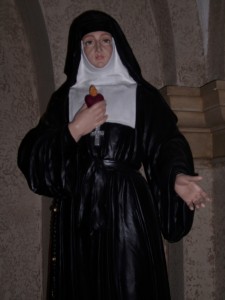In the August 2020 issue of MAGNIFICAT, author Anthony Esolen writes of St. Jane de Chantal’s life and mentions one of her Visitation Sisters, Sister Claire Marie Francoise de Cusance.

Who was this Visitandine, and what did St. Jane write to her?
This religious belonged to the ancient family of the Counts of Berghen, Champlitte, and Belvoir. At the age of thirteen, upon the foundation of the Monastery of Champlitte, she was taken there and given the title of Foundress. Her arrival was the signal for a great ovation. Cannons boomed forth their welcome, while the Magistrates harangued, and the people cheered her, acclaiming the great and good deeds of her ancestors. In this wise did the child enter into her new life of poverty, obedience, and chastity. Soon after her entrance the war between France and Spain obliged the Community to leave Champlitte for the little town of Gray. Here fresh trials awaited it; the plague broke out, and so awful were its ravages that the town was soon a veritable sepulchre. Yet none of the terrors that surrounded her shook the resolution of the brave child. Full of confidence in God she remained calm and joyful in the midst of unheard-of privations.
The fame of her courage and her virtue went abroad and even before her profession she was the object of public veneration, for the people loved her and claimed her as their own heroine. At the age of sixteen, Sister Claire-Marie-Françoise de Cusance made her solemn vows and became the Saint Stanislaus Kostka of the Visitation. She died two years after her profession, having spent those eighteen years of life more like an angel than a woman, and having enjoyed many supernatural communications. No sooner was her death known, than the Mayor ordered all the bells of the town of Gray to be tolled, on which the inhabitants at once announced their intention of assisting at the obsequies with torch-lights to honour not so much her birth as her high virtue. The Visitation Monastery had not as yet a cemetery of their own, so the religious of the Annunciation, at their urgent request were given the holy remains, which for some days they exposed to public veneration. Numerous were the graces obtained during those days by the devout inhabitants through the mediation of the holy nun. Her portrait was circulated in Flanders where [like Sœur Thérèse of Lisieux in our day] she was venerated, though not yet on the Altars of the Church. Fourteen days after the obsequies had been celebrated a religious of the Annunciation wrote to the Mother Superior of the Visitation at Gray. “This dear deceased is still quite beautiful and her body quite flexible, the veins are to be seen in her person as in a living body, which proves to us that it was truly the temple of a pure and angelic soul. Several persons have noticed a fragrant perfume exhaling from the coffin, and others have received extraordinary graces and interior illumination when praying beside it.” (Taken from Vol. IX. of the “Lives of the Sisters of the Visitation.”)
CVII.
To Sister Claire-Marie-Françoise de Cusance at Gray
Vive ✠ Jésus!
Annecy, 1640.
My dearest Daughter,
Your letter fills me with tender compassion, but it also gives me very real comfort, seeing how joyfully God is enabling you to make your passage through this life to Him. You will love and adore Him in an eternity of glory, for this is the only good that is worth setting our hearts upon. Here we are all regretting your absence, and envying you your happiness, but our regret and our envy are more than balanced by our gratitude to God who is taking you so mercifully to Himself. Oh! how hard and long is this life for those who yearn to be with Him! You must do, my daughter, as your good Mother desires about your state of health.
Most earnestly do I beg of you to ask God that I may live and die in His grace and according to His good pleasure. Do not refuse me this favor, and when you see Him do not forget to speak to Him about me. Be kind to me in this.
I remain,
Yours affectionately in His love. Amen
There are other Visitandine mystics to whom St. Jane wrote and we will feature them subsequent to this series on Sister de Cusance.